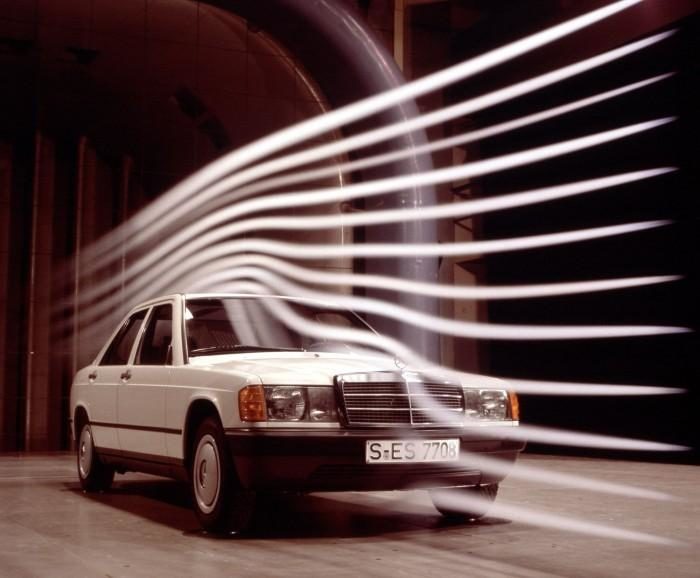You can still see them driving. Because they are just fine cars. And recently I saw a Mercedes 190 owner on the curb doing an Action restoration on the wheel rims with filler and two spray cans. The result has turned out quite neat. Experts once seriously doubted whether the 'small' Mercedes had any chance of success. The 190 series was a success. We have known for a long time: Experts are not always right.
The Mercedes 190 was presented at the end of 1982
The idea was to make Het Merk more accessible and to lower the average age of Mercedes-Benz M / V drivers. The car was soon nicknamed 'Baby-Benz', but was conceived within the Daimler-Benz group as Baureihe W201 and placed under the E-class, S-class and SL-class as “compact-class”. The step down into the future became a milestone for the development of Mercedes-Benz models.
The 190 looked really 'new', but remained unmistakably a true Mercdes-Benz. The man responsible for the innovative design was Bruno Sacco. The first models in the W201 series were the 190 and 190E, which quickly became a huge success and also provided the foundation for later C-class (W202) generations.
The 190 also had a revolutionary new chassis design.
The main feature of that suspension was the independent multi-link suspension. Each of the rear wheels was optimally kept on the road by five independent suspension points, with lateral and longitudinal forces effectively balanced in all driving situations. This improved the handling and resulted in astonishingly good handling. The new rear axle design was also lighter and more compact than its predecessors. Of course there were people who thought that was all a bit excessive. In the archive we found a copy of the idea that 'TRo' had about the German approach. 'TRo'may report! The front axle had individual triangular wishbones and anti-dive controls. This gave the W201 excellent linear stability, and due to the relatively compact construction it also provided a lot of uncluttered space under the hood. As a result of which there was later more room for larger engines.
The kick-off was in 1982
Mercedes-Benz started the production of the 190 and 190E models in 1982; the 190D and 190E 2.3-16 came in 1983 and 1984. The first two gasoline models, were equipped with four-cylinder engines of 1.997 cc, and delivered resp. 90 pk and 122pk. The engines were based on the 200 power source used in the Mercedes-Benz 123 (W1980). For the 190, engine power was limited by reducing the intake and exhaust, a modified camshaft and smaller valves. The engine of the 190E delivered considerably more power thanks to the mechanically electronically controlled Bosch KE-Jetronic injection system, allowing the car to reach a top speed of 195 km / h.
The selling point: the diesel
A year later, the 190D came together with a newly developed four-cylinder diesel engine of 1997 cc that ushered in exemplary encapsulation and the most advanced diesel technology in Mercedes-Benz passenger cars. The 'whispering diesel' with its capacity of thick 70 hp and its low fuel consumption turned out to be a top seller. He heralded the definitive end of the era when truck drivers saw Mercedes-Benz diesel drivers as highly regarded colleagues. 452,806 190Ds were built and sold without any problems during its ten-year production period.
The sporty showpiece
In 1984 the new 190E 2.3-16 made its debut as the top model in the 190 series. That was a very fast, sporty touring car. The 2.299 cc displacement four-cylinder engine had a redesigned head with two intake and two exhaust valves. This increased the engine power to more than 180 hp and the car accelerated from a standstill to 100 km / h in just 7,5 seconds. The top speed was 230 km / h.
There is of course much more to say about the Mercedes-Benz 190 line. And we will certainly do that again soon AutoMotorKlassiek, the largest classic monthly magazine in the Dutch language area. Already have a subscription?
The state of affairs now
Currently these Mercedes are offered from 'scratchy' to top condition. They were and are fantastic cars. But nothing is incorruptible. When purchasing, do not assume that the car you want to buy is perfect.
When planning to buy a diesel, take into account that the world has gone crazy when it comes to the environment. Diesel driving is being tackled. Fortunately, we still have Schiphol to travel in an environmentally friendly and tax-free way.







The 190s are starting to get seriously pricey. A few years ago you bought a pretty nice one with not too many kilometers for 2000 euros, but now I see them for at least two to three times and with special motorizations for really serious amounts. There are quite a few driving around here in the village.
This W201 and the W124 of the same Bruno Sacco were top machines and also very economical. With normal use and maintenance they can last forever.
My W124 200D now has 570.000 trouble-free mileage and still drives as if it was delivered yesterday.
I would say sign up for 'around the clock'!
Or the port of Rotterdam to go emission-free cruising! ???